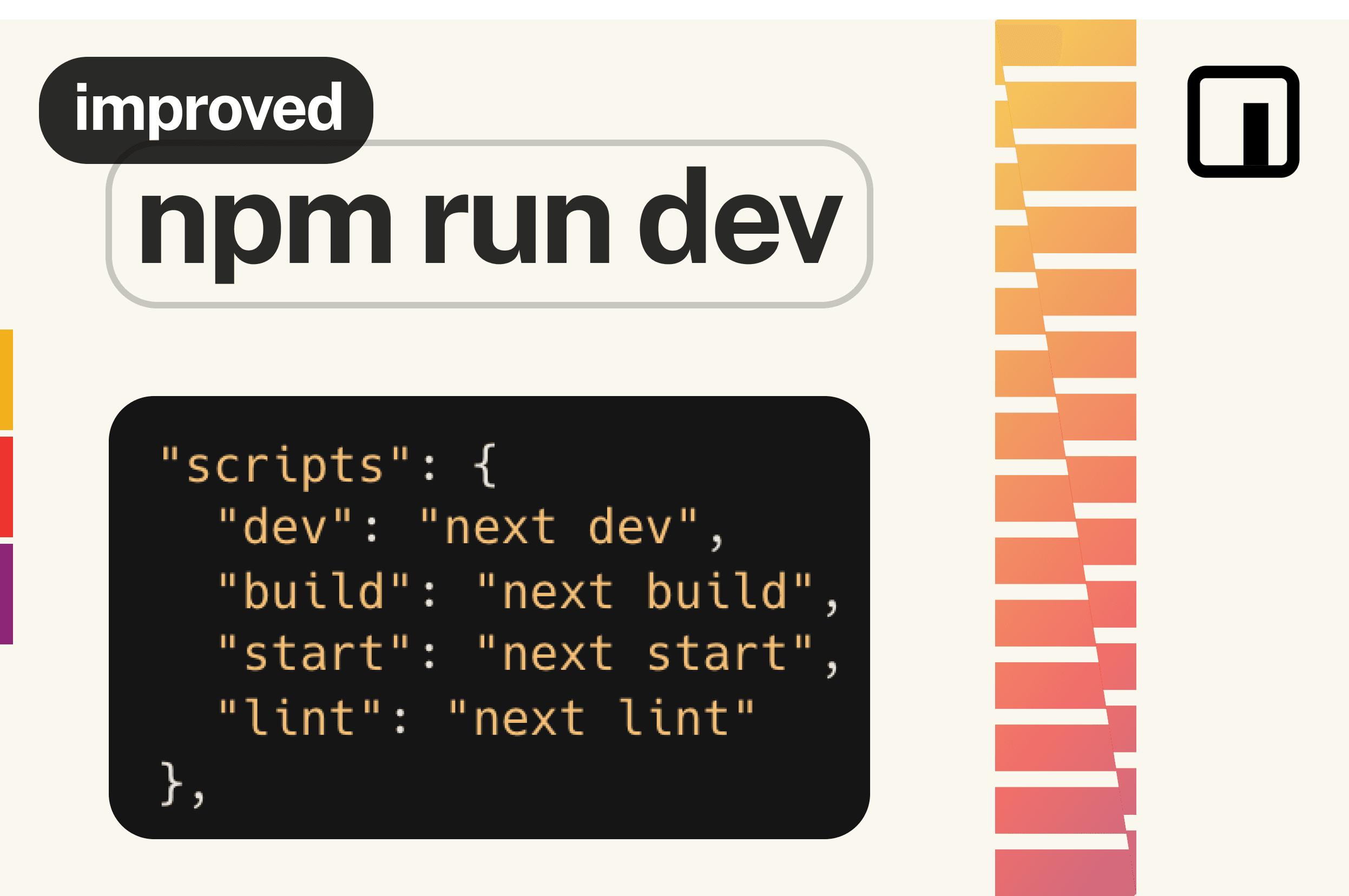
Supercharge `npm run dev` with package.json scripts

npm run dev is the standard for "run my website locally," but how does it work? How can we expand its functionality? In this post we'll look at:
- How to configure what
npm run devdoes. - How to decompose complex commands into granular units.
- How to run multiple commands in parallel.
- How to run pre-requisites without losing normal
Ctrl-Cbehavior. - How to add seed data (if none exists) when starting up a Convex backend.
As a motivating example, here are some npm run scripts defined in the convex-helpers example app. We'll cover what each piece does
1 "scripts": {
2 "dev": "npm-run-all --parallel dev:backend dev:frontend",
3 "build": "tsc && vite build",
4 "dev:backend": "convex dev",
5 "dev:frontend": "vite",
6 "predev": "convex dev --until-success",
7 "test": "vitest"
8 },
9What does npm run dev do?
npm run dev sets up a local development server, enabling real-time code changes and instant feedback. This command simplifies the development process by automatically reloading the application whenever you make changes to the code.
How and where they're defined
npm run executes commands that are defined in your package.json in your project's workspace. These commands are often pre-configured when you start your repo from a command like npm create vite@latest with commands for:
dev: Run a development environment. This often includes auto-reloading the UI when files change. For Vite this isviteand Next.js isnext dev.build: Build the website for deployment. This will generally compile and bundle all your html, css, and javascript. For Vite this isvite buildand Next.js isnext build.test: Run tests - if you're using Jest, it's just"test": "jest"orvitestfor Vitest.
Here's a basic example from Next.js:
1// in package.json
2{
3// ...
4 "scripts": {
5 "dev": "next dev",
6 "build": "next build",
7 "start": "next start",
8 "lint": "next lint"
9 },
10//...
11Here you can run npm run dev or npm run lint etc.
You can learn more about npm run in the docs.
Why use package.json scripts?
It's a fair question why one would put commands that are already so simple into package json scripts. Why not just call jest or vite or next build? There's a few good reasons:
- You can save the default parameters for
npm runcommands so you don't have to remember or document the "standard" way of starting something. We'll see below how you can configure it to chain commands and run others in parallel. - It allows you to easily run commands that are installed by
npmbut not globally accessible from your shell (terminal).1 When you install things likenpm install -D vitest, it installsvitestintonode_modules/.bin.2 You can't runvitestdirectly in your shell,3 but you can have a config like:"scripts": { "test": "vitest" }andnpm run testwill runvitest. - It always runs with the root of the package folder as the "current directory" even if you're in a subdirectory. So you can define a script like
"foo": "./myscript.sh"and it will always look formyscript.shin the package root (in the same directory as package.json). Note: you can access the current directory where it was called via theINIT_CWDenvironment variable. - You can reference variables in the
package.jsoneasily when the script is run fromnpm run. For instance, you can access the "version" of your package with thenpm_package_versionenvironment variable, likeprocess.env.npm_package_versionin js or$npm_package_versionin a script. - If you have multiple workspaces (many directories with their own package.json configured into a parent package.json with a "workspaces" config), you can run the same command in all workspaces with
npm test --workspacesor one withnpm run lint --workspace apps/web.
Does npm run dev work with yarn / pnpm / bun?
Yes! Even if you install your dependencies with another package manager, you can still run your package scripts with npm.
1yarn # similar to `npm install`
2npm run dev # still works!
3You don't have to remember that npm run dev maps to yarn dev (or yarn run dev). The same goes for npx: npx convex dev works regardless of what package manager you used to install things.
Running multiple commands in parallel with npm run all or concurrently
There are a couple packages you can use to execute npm commands concurrently:4
Here's an example of npm-run-all:
1 "scripts": {
2 "dev": "npm-run-all --parallel dev:backend dev:frontend",
3 "dev:backend": "convex dev",
4 "dev:frontend": "vite",
5 },
6This defines three npm run scripts.
npm run dev:backendrunsconvex dev.npm run dev:frontendrunsvite.npm run devruns bothconvex devandvitein parallel vianpm-run-all.
Both outputs are streamed out, and doing Ctrl-C will interrupt both scripts. With npm run all, you can easily run both the Convex backend and frontend services with one command.
Here's an example of using concurrently to run the same project:
1 "scripts": {
2 "dev": "concurrently \"npm run dev:backend\" \"npm run dev:frontend\"",
3 "dev:backend": "convex dev",
4 "dev:frontend": "vite",
5 },
6This set of package json scripts run multiple npm run commands in parallel similar to npm run all but uses the concurrently package which provides additional features like better handling of command outputs and more control over execution control.
Enhancing npm run dev with predev and postbuild
You can specify commands to run before (pre) or after (post) another command (say, X) by naming your command preX or postX. In the example:
1 "scripts": {
2 "dev": "npm-run-all --parallel dev:backend dev:frontend",
3 "dev:backend": "convex dev",
4 "dev:frontend": "vite",
5 "predev": "convex dev --until-success",
6 },
7This will run convex dev --until-success, before the "dev" command of npm-run-all --parallel dev:backend dev:frontend.
Chaining with "&&"
For those used to shell scripting, you can run two commands in sequence if the previous one succeeds with commandA && commandB. This works on both Windows and Unix (Mac / Linux).
However, there's a couple advantages to just using pre-scripts:
- You can run either command with
npm run dev --ignore-scriptsto not do the "predev" script, ornpm run predevto explicitly only do the "predev" step. - The Ctrl-C behavior is more predictable in my experience. In different shell environments, doing Ctrl-C (which sends an interrupt signal to the current process) would sometimes kill the first script but still run the second script. After many attempts we decided to switch to "predev" as the pattern.
Run interactive steps first
The first time you run Convex by using npx convex dev (or npm run dev with the above scripts), it will ask you to log in if you aren't already, and ask you to set up your project if one isn't already set up. This is great, but interactive commands that update the output text don't work well when the output is being streamed by multiple commands at once. This is the motivation for running npx convex dev --until-success before npx convex dev.
convex devsyncs your functions and schema whenever it doesn't match what you have deployed, watching for file changes.- The
--until-successflag syncs your functions and schema only until it succeeds once, telling you what to fix if something is wrong and retrying automatically until it succeeds or you Ctrl-C it. - By running
npx convex dev --until-success, we can go through the login, project configuration, and an initial sync, all before trying to start up the frontend and backend. - The initial sync is especially helpful if it catches issues like missing environment variables which need to be set before your app can function.
- This way the frontend doesn't start until the backend is ready to handle requests with the version of functions it expects.
Seeding data on startup
If you change your "predev" command for Convex to include --run it will run a server-side function before your frontend has started.
1 "scripts": {
2 //...
3 "predev": "convex dev --until-success --run init",
4 //...
5 },
6The --run init command will run a function that is the default export in convex/init.ts. You could also run --run myFolder/myModule:myFunction. See docs on naming here.
See the Convex documentation on query names. See this post on seeding data for more details. In essence, you can define an internalMutation that checks if the database is empty and, if so, inserts a collection of records for testing or setup purposes.
tsc?
If you use TypeScript, you can run a type check / compile your typescript files with a bare tsc. If your tsconfig.json is configured to emit types, it will write out the types. If not, it will just validate the types. This is great to do as part of the build, so you don't build anything that has type errors. This is why the above example did:
1 "build": "tsc && vite build",
2Passing arguments to npm run commands
If you want to pass arguments to a command, for instance passing arguments to your testing command to specify what test to run, you can pass them after a -- to separate the command from the argument. Technically you don't need -- if your arguments are positional instead of --prefixed, but it doesn't hurt to always do it in case you forget which to do it for.
1npm run test -- --grep="pattern"
2Handling common npm script errors
When working with npm run commands, you might encounter various errors. Here are some common issues and how to handle them:
- Command Not Found: Ensure the command is installed locally in your node_modules and correctly referenced in your
package.jsonscripts. - Permission Denied: This often occurs on Unix-based systems. You might need to adjust file permissions or use
sudocautiously. - Syntax Errors: Double-check your
package.jsonfor any syntax errors, such as missing commas or incorrect script names.
Integrating npm run scripts with CI/CD pipelines
Integrating npm run scripts with CI/CD pipelines can automate your development workflow, ensuring consistent builds and deployments. Most CI/CD tools like GitHub Actions, GitLab CI, and Jenkins support running npm scripts as part of their pipeline configuration.
For example, in a GitHub Actions workflow:
1name: Run Tests
2
3on: [pull_request, push]
4
5jobs:
6 build:
7 runs-on: ubuntu-latest
8 steps:
9 - uses: actions/checkout@v4
10 - uses: actions/setup-node@v4
11 - run: npm ci
12 - run: npm run test
13This yaml file makes sure that every push to your repository triggers the CI pipeline, running your tests and building your project automatically.
Summary
We looked at some ways of using package.json scripts to simplify our workflows. Who knew how much power could rest behind a simple npm run dev? Looking at our original example:
1 "scripts": {
2 "dev": "npm-run-all --parallel dev:backend dev:frontend",
3 "build": "tsc && vite build",
4 "dev:backend": "convex dev",
5 "dev:frontend": "vite",
6 "predev": "convex dev --until-success",
7 "test": "vitest"
8 },
9devruns the frontend and backend in parallel, afterpredev.builddoes type checking viatscbefore building the static site.dev:backendcontinuously deploys the backend functions to your development environment as you edit files.dev:frontendruns a local frontend server that auto-reloads as you edit files.predevruns beforedevand does an initial deployment, handling login, configuration, and an initial sync as necessary.testuses Vitest to run tests. Note:npm testis shorthand fornpm run testalong with other commands, but they're special cases.npm run testis the habit I suggest.
Footnotes
-
The way your shell finds which command to run when you type
npmis to check the shell'sPATHenvironment variable (on unix machines anyways). You can see your own withecho "$PATH". It checks all the places specified in$PATHand uses the first one. ↩ -
Technically you can override & specify where npm installs binaries. ↩
-
If you really want to, you can run
npm exec vitest,npx vitestfor short,./npm_modules/.bin/vitestdirectly, or add.npm_modules/.binto your PATH. ↩ -
Some people use a bare
&to run one task in the background, but that is not supported on Windows, and interrupting one command won't necessarily kill the other. ↩
Convex is the backend platform with everything you need to build your full-stack AI project. Cloud functions, a database, file storage, scheduling, workflow, vector search, and realtime updates fit together seamlessly.